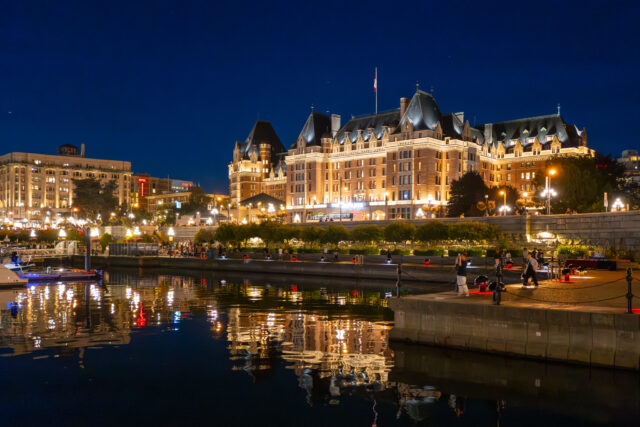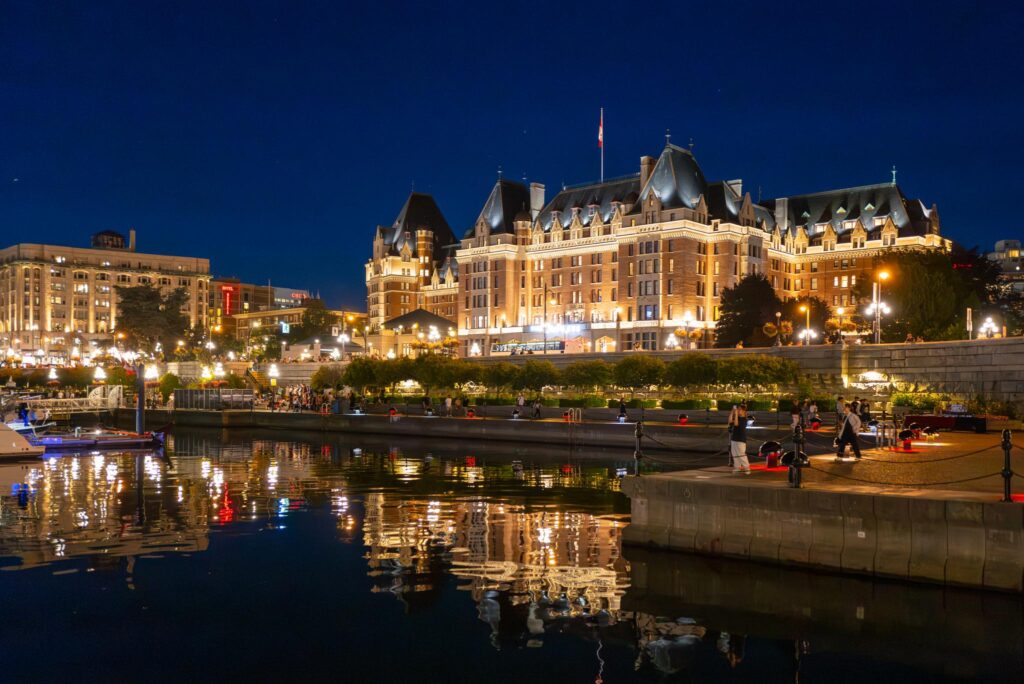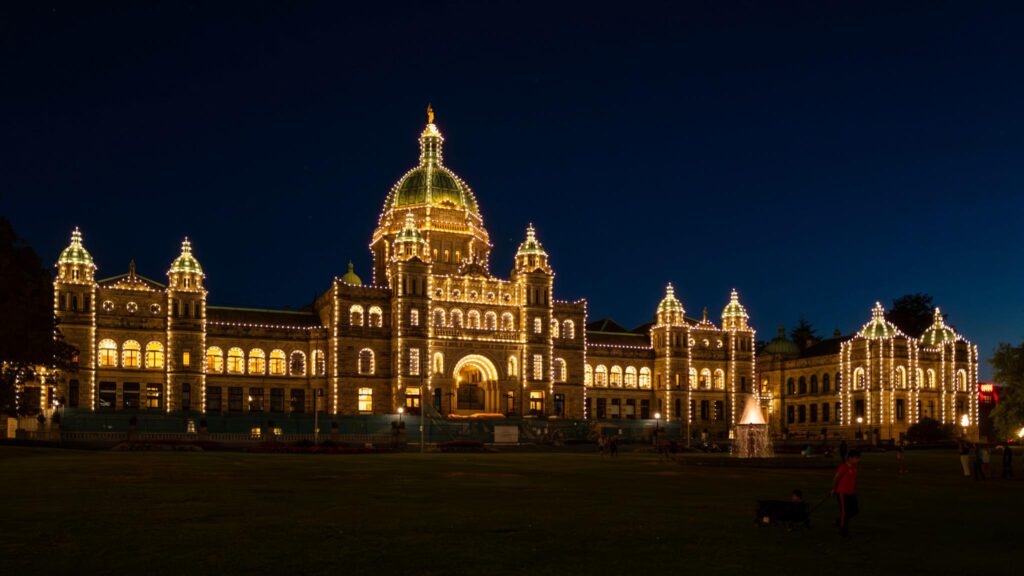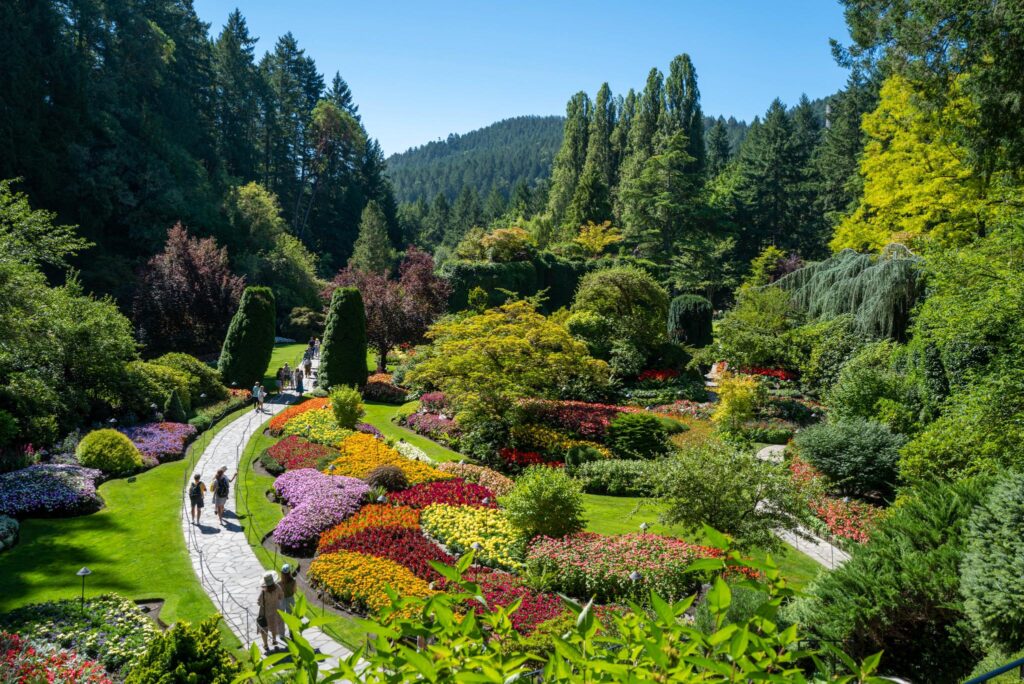If you were determined to travel light for a photographic trip to a new city, perhaps like me, you would try to manage with a single camera. With such an aim in mind, I had no qualms about taking just my Leica Q2 on the road with me. Here’s how it performed on the street, in the garden, during the day, and after dark.
In a recent article, I described a visit to Vancouver, BC. This was the first destination in a three-city, two-ferry trip to the Western border of Canada and the United States. After a splendid visit to that beautiful city, we took a two-hour ferry journey to our next stopover.
Western Canada and the United States, and a scenic ferry trip from Vancouver to Victoria
Victoria, the capital of British Columbia, sits at the southern tip of Vancouver Island. It was the smallest of the three cities on our itinerary, but offered no shortage of photographic opportunities. We stayed at the Empress Hotel, at Victoria’s marina, just around the corner from the Parliament of British Columbia. The hotel dominates the marina frontage, looking particularly splendid when illuminated.
The photograph above provided my first opportunity to try out the AI-assisted denoise feature in Lightroom. Hand-holding the camera, shooting wide-open at 1/50s resulted in an auto-ISO selection of 3200. The original image suffered from significant noise. The denoise routine sorted that out jiffy-quick. Well, it took 2 minutes on my M1-equipped MacBook Air, but I was pleased with the outcome.
British colonial origins
The name of both the city and the hotel are clues to the influence of Great Britain in the founding of Victoria. It began life as a trading outpost for the Hudson’s Bay Company in 1843. The settlement underwent several name changes before finally being called Fort Victoria, in honour of the reigning monarch. It has a fascinating history, unfortunately beyond the scope of this article. Suffice it to say that opium, gold, and naval exploits all feature prominently.
Lots to see around the marina
The marina area in front of the hotel was bustling with tourists enjoying beautiful floral displays. These included a pair of orcas made from a collection of multicoloured plants. I had noticed the profusion of flower arrangements and hanging baskets while in Vancouver. Floral decoration of municipal areas seems to be popular in this part of Canada.
Visitors lined up to hop on water taxis ferrying people around the harbour. They also travelled across to Fisherman’s Wharf — a popular spot that I rode to on a rented bike (see below).
An aspect of visiting new cities I especially enjoy is wandering around its streets, learning the lay of the land. Along the way, I hope to see a few sights worth photographing. I am on the lookout for interesting buildings, people, wall art, or vistas. The centre of Victoria is quite compact, and so I found it easy to navigate, building a mental map of its layout as I went.
Street life
You never know what you might find on such a stroll.
Leica Q2 on the road gets into a tight squeeze
For example, I stumbled across Fan Tan Alley in the city’s small Chinatown. This is reputedly the narrowest street in North America: less than 0.9 m (3 ft) at its narrowest point. Named after a Chinese gambling game, Fan Tan, the street has a colourful, if chequered history, which included opium production. Its tall sides made for deep shadows, which people walked in and out of as they perused its many stores.
Not for the claustrophobic…
Elsewhere, city streets featured attractive stone and brick buildings. Further from the historic city centre, a more modern architectural style emerges.
Victorian architecture
We found excellent restaurants within easy walking distance of the hotel. Fresh seafood was on the menu, given Victoria’s coastal location. The locals were very friendly and the restaurant staff were happy to pose for a few portraits. One particularly enjoyable restaurant was named ‘Wind Cries Mary’. Hendrix fans will recognise the name. It seems the owner is a Hendrix fan too. Highly recommended if you are in the neighbourhood.
Smiling, happy people
Fisherman’s Wharf
San Francisco is not the only West-Coast city that has a district of this name. Victoria’s Fisherman’s Wharf is smaller, but equally overrun with tourists. Its most characteristic feature is a collection of brightly coloured houseboats. A short walk from the restaurants and gift shops, this eclectic collection of floating homes makes for a colourful scene. Their reflections in the calm water add to their charm.
Greys and browns are out, primary colours are in
Butchart Gardens
A nearby attraction, practically synonymous with Victoria, is the world-famous Butchart Gardens. Just as a visit to Stanley Park is obligatory when visiting Vancouver, so is a visit to Butchart Gardens when in Victoria.
I come from a country that prides itself on its horticultural skills and delightful country gardens, often associated with historic stately homes. But, I have to admit, I have never seen as beautiful a garden as this.
Butchart Gardens began life as a limestone quarry, owned by the Butchart family. They owned a cement manufacturing business and were drawn to the area because of its rich limestone deposits. The family had an interest in landscape gardening, having previously commissioned the creation of a Japanese Garden at their home. So, when the quarry was exhausted, Jenny Butchart began turning it into the Sunken Garden.
She oversaw its construction, beginning in 1909, until its completion in 1921. In 1926, they added the Italian Garden, and in 1929, the Rose Garden. The entire gardens now occupy twenty-two hectares, and have been designated a National Historic Site of Canada.
Scenes from Butchart Gardens
There is a cliché: ‘You could point a camera in any direction, press the button, and take a lovely photo’. In Butchart Gardens, that is almost true. If you love plants, gardening, landscapes, or nature, this is the place for you. The nature point is moderately debatable, since the gardens present a series of highly contrived scenes. Nevertheless, they are beautiful.
Sunk, but not without trace
The Sunken Garden deserves special mention. Visitors can either peer down into this extraordinary space, or descend a series of steps and immerse themselves in it. You could easily imagine that you had stepped through a portal into some magical world. That is, if not for the many other tourists dotted along its paths. Even so, the landscaping has been designed to ensure sufficient nooks and niches to trick me into thinking I was completely alone.
The magical Sunken Garden
In addition to vistas of pristine landscapes, the garden also featured beds devoted to specific flower varieties. The Dahlia bed was a particular highlight.
Known to the Aztecs and named after the Swedish botanist, Anders Dahl
I have included only a limited selection of photographs in this article. I have many others in my collection! Hopefully, they convey an impression of how magnificent these gardens are.
The Leica Q2 on the road
All the photos in this article were taken with my Q2. I have made the case in previous travelogues that this camera is versatile enough to handle almost any eventuality. I was able to tackle a wide diversity of subjects and lighting conditions with confidence.
Its lens delivered crystal sharp images. The bright August sun produced saturated colours and cast deep shadows all around. Nevertheless, the Q2’s sensor rendered the colours superbly and allowed recovery of many details in the shadows. I can highly recommend both the Leica Q2 and Victoria!

We enjoyed our visit enormously, but after a few days, it was time to say farewell. We boarded another ferry and headed out through the Strait of Juan de Fuca, on our way to the Puget Sound. Seattle, here we come!
Read more from the author
Read the first article in this series
Want to contribute an article to Macfilos? It’s easy. Just click the “Write for Us” button. We’ll help with the writing and guide you through the process.


















































Hi Keith,
A lovely article and wonderful photos. I live one and a half hours north of Victoria and it is my favourite place for shutter therapy.
Thanks for bringing back good memories — and photos — of Victoria. Though I think you go to classier restaurants than we ever visit. I should have guessed that from the brunch photos!
I was also very happy that you provided some timings on the AI sharpening tools. As suggested here, I downloaded Topaz Photo AI and Topaz Gigapixel AI tryouts for a 2013 MacPro ww/64gb memory and dual 3gb video cards.
I took a 50mb raw file and asked for sharpening and noise reduction. I wondered whether the M1, or for some of you, the M2 chip, would beat out my Xeon 3.9ghz 8 core. Topaz Photo finished in 28 seconds; Gigapixel in 5 minutes and 40 seconds.
Your ‘2 minute mile’ is sounding good!
Well done Keith,
what a trip to take, simply amazing. The Q colors are outstanding. The camera can do almost everthing, except telephoto images. And that doesn’t hurt to much. It’s far better to enjoy the superb images it gave to you than crying about missed chances of bird and whatever subjects, not to forget the macro-capabilities of it.
Superb and versatile.
Many greetings
Dirk
Agree with you (almost) entirely, Dirk having spent a short holiday in Puglia with my Q3’s maiden voyage